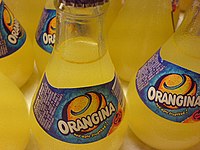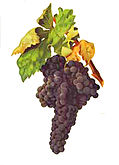Portal:Drink
The Drink Portal
A portal dedicated to all beverages
Introduction

A drink or beverage is a liquid intended for human consumption. In addition to their basic function of satisfying thirst, drinks play important roles in human culture. Common types of drinks include plain drinking water, milk, juice, smoothies and soft drinks. Traditionally warm beverages include coffee, tea, and hot chocolate. Caffeinated drinks that contain the stimulant caffeine have a long history.
In addition, alcoholic drinks such as wine, beer, and liquor, which contain the drug ethanol, have been part of human culture for more than 8,000 years. Non-alcoholic drinks often signify drinks that would normally contain alcohol, such as beer, wine and cocktails, but are made with a sufficiently low concentration of alcohol by volume. The category includes drinks that have undergone an alcohol removal process such as non-alcoholic beers and de-alcoholized wines. (Full article...)
Selected article -
Did you know? -
- ... that Al-Rantisi Hospital can extract drinking water from air?
- ... that an image of MacCarthy's Bar on the front cover of a book featured a staff member posing as a nun drinking a pint of Guinness and the surprise appearance of a dog?
- ... that The Drunkard's Progress suggests that a single social drink leads to poverty, crime, and suicide?
- ... that Assyrian Christian couples drink dust from the tombs of martyrs and are crowned during their weddings?
- ... that salt marsh snakes drink only rainwater?
- ... that the John Snow pub is named for a shy British epidemiologist who did not drink?
General images -
Selected image -
Selected biography -

Selected quote -
| “ | If you are cold, tea will warm you. If you are heated, it will cool you. If you are depressed, it will cheer you. If you are excited, it will calm you. | ” |
| — William Ewart Gladstone |
Selected ingredient -

Carrageenans or carrageenins (/ˌkærəˈɡiːnənz/ KARR-ə-GHEE-nənz; from Irish carraigín 'little rock') are a family of natural linear sulfated polysaccharides that are extracted from red edible seaweeds. Carrageenans are widely used in the food industry, for their gelling, thickening, and stabilizing properties. Their main application is in dairy and meat products, due to their strong binding to food proteins. In recent years, carrageenans have emerged as a promising candidate in tissue engineering and regenerative medicine applications as they resemble native glycosaminoglycans (GAGs). They have been mainly used for tissue engineering, wound coverage, and drug delivery.
Carrageenans contain 15–40% ester-sulfate content, which makes them anionic polysaccharides. They can be mainly categorized into three different classes based on their sulfate content. Kappa-carrageenan has one sulfate group per disaccharide, iota-carrageenan has two, and lambda-carrageenan has three.
A common red seaweed used for manufacturing the hydrophilic colloids to produce carrageenan is Chondrus crispus (Irish moss), which is a dark red parsley-like alga that grows attached to rocks. Gelatinous extracts of the Chondrus crispus seaweed have been used as food additives since approximately the fifteenth century. Carrageenan is a vegetarian and vegan alternative to gelatin in some applications, so may be used to replace gelatin in confectionery and other food. There is no clinical evidence for carrageenan as an unsafe food ingredient, mainly because its fate after digestion is inadequately determined.
The first industrial scale commercial cultivation of Eucheuma and Kappaphycus spp. for carrageenan was developed in the Philippines. The global top producers of carrageenan are the Philippines and Indonesia. Carrageenan, along with agar, are used to produce traditional jelly desserts in the Philippines called gulaman. (Full article...)Topics
| General topics: | Bartending • Bottling • Drinking • Drinking water • Bottled water • Mineral water • Coffee • Energy drink • Juice • Tea • Milk • Plant milk • Pasteurization • Refrigeration • Steeping • Water purification |
| Alcoholic beverages: | Beer • Brandy • Brewing • Caffeinated alcoholic drinks • Cider • Cocktails • Distillation • Fermentation • Hard soda • Liquor • Liqueur • Malt drink • Mead • Proof • Rice Wine • Schnapps • Vodka • Whiskey • Wine |
| Soft Drinks: | Carbonation • Cola • Orange soft drink • Frozen carbonated drink • Root beer • Soda water • Lithia water • |
| Miscellaneous: | Drink industry • Lemonade • Limeade • Orange drink • Slush (beverage) |
List articles
Subcategories
Related portals
WikiProjects


WikiProject Food & Drink is an association of Wikipedians with an interest in culinary-related subjects. They have come together to co-ordinate the development of food and drink articles here on Wikipedia as well as the many subjects related to food such as foodservice, catering and restaurants. If you wish to learn more about these subjects as well as get involved, please visit the project.
 WikiProject Beer – covers Wikipedia's coverage of beer and breweries and microbreweries
WikiProject Beer – covers Wikipedia's coverage of beer and breweries and microbreweries
![]() WikiProject Wine – aims to compile thorough and accurate information on different vineyards, wineries and varieties of wines, including but not limited to their qualities, origins, and uses.
WikiProject Wine – aims to compile thorough and accurate information on different vineyards, wineries and varieties of wines, including but not limited to their qualities, origins, and uses.
| Child projects: | Task forces: (All inactive) |
| Related projects: | |
Things you can do
 |
Here are some tasks awaiting attention:
|
Associated Wikimedia
The following Wikimedia Foundation sister projects provide more on this subject:
-
Commons
Free media repository -
Wikibooks
Free textbooks and manuals -
Wikidata
Free knowledge base -
Wikinews
Free-content news -
Wikiquote
Collection of quotations -
Wikisource
Free-content library -
Wikiversity
Free learning tools -
Wiktionary
Dictionary and thesaurus
More portals
- Portals with triaged subpages from June 2018
- All portals with triaged subpages
- All portals
- Portals with no named maintainer
- Random portal component with over 50 available subpages
- Random portal component with 6–10 available subpages
- Random portal component with 21–25 available image subpages
- Random portal component with 16–20 available subpages
- Beverage portals
- Drink portal
- Drinks






































































